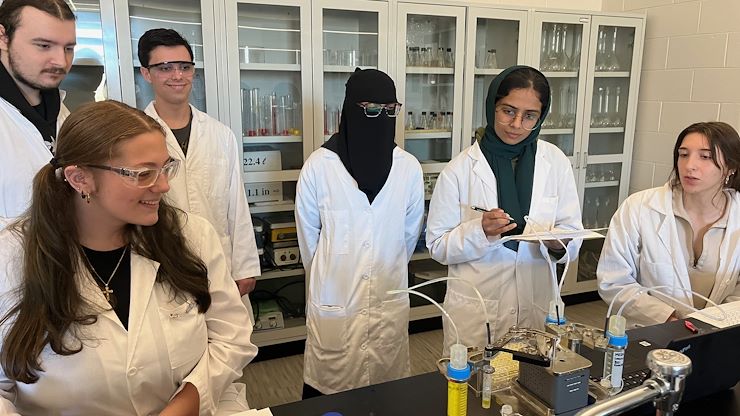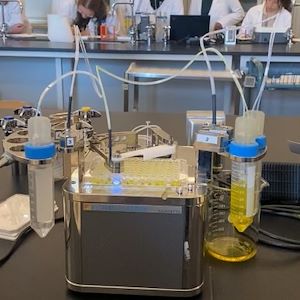
Merck Scientist Erin Coppola introduced students in Montgomery County Community College's Instrumentation in Biotechnology class to the world of robotic automation in biotechnology using Mantis, a liquid handling robot.
It was a day unlike any other for students in Biotechnology Professor Dr. Margaret Bryans’ BIT-123 Instrumentation in Biotechnology class, as they were treated to a hands-on experience that merged robotics and science in a battle of wits and skill.
 The excitement kicked off with a guest lecture from Erin Coppola, Scientist, Biology-Discovery
Automation, of Merck & Co., accompanied by her enthusiastic intern, Maameyaa Asiamah.
Together, they introduced the class to the fascinating world of automation and robotics
in biotechnology, showcasing a cutting-edge liquid handling robot known as the Mantis,
manufactured by Formulatrix.
The excitement kicked off with a guest lecture from Erin Coppola, Scientist, Biology-Discovery
Automation, of Merck & Co., accompanied by her enthusiastic intern, Maameyaa Asiamah.
Together, they introduced the class to the fascinating world of automation and robotics
in biotechnology, showcasing a cutting-edge liquid handling robot known as the Mantis,
manufactured by Formulatrix.
With the groundwork laid, students eagerly transitioned from theory to practice, heading into the lab where they were divided into two teams. Each team was equipped with their own Mantis robot, eager to explore and program their new mechanical ally to dispense precise volumes into 96-well plates.
But the real excitement was just beginning. Coppola challenged each team to a creative twist on the classic game of Battleship. First, they crafted paper 96-well plate maps to position their five “ships.” Then, armed with their programming skills, they set the Mantis to dispense oxidizing reagents into specific wells, simulating their ship locations, while filling the remaining wells with water.
 Once the maps were set, the competition heated up. Teams took turns programming the
Mantis to dispense luminol into three wells per round. The magic happened when Luminol
reacted with the oxidizing agents—wells would flash blue for a brief moment, mimicking
hits in a high-stakes game of strategy. Each round was met with laughter, cheers,
and the thrill of victory or the agony of defeat as students communicated hits and
confirmed sunk ships.
Once the maps were set, the competition heated up. Teams took turns programming the
Mantis to dispense luminol into three wells per round. The magic happened when Luminol
reacted with the oxidizing agents—wells would flash blue for a brief moment, mimicking
hits in a high-stakes game of strategy. Each round was met with laughter, cheers,
and the thrill of victory or the agony of defeat as students communicated hits and
confirmed sunk ships.
Through this engaging challenge, students encountered and overcame technical issues with the robots, mirroring the challenges scientists face in real-world scenarios. With each round, they refined their skills and deepened their understanding of automation's pivotal role in biotechnology. Not only did they learn to navigate the complexities of programming, but they also walked away with some cool Merck merchandise as a bonus.
Overall, the day was a resounding success, with Coppola planning to adapt this innovative exercise for high school STEM programs, intending to inspire the next generation of scientists with manual pipetting. In a world where technology and biotechnology are increasingly intertwined, this class proved to be a perfect blend of fun and learning—a true testament to the spirit of innovation.
